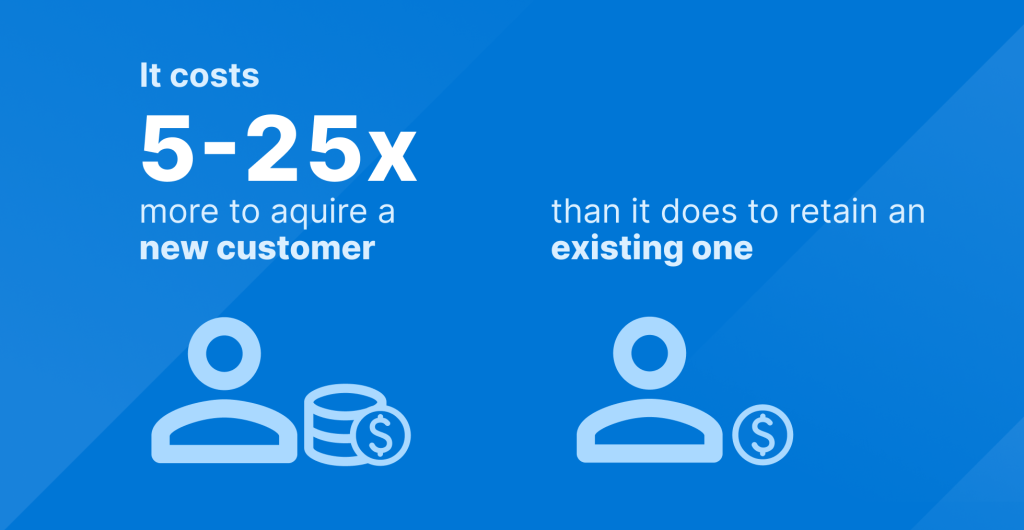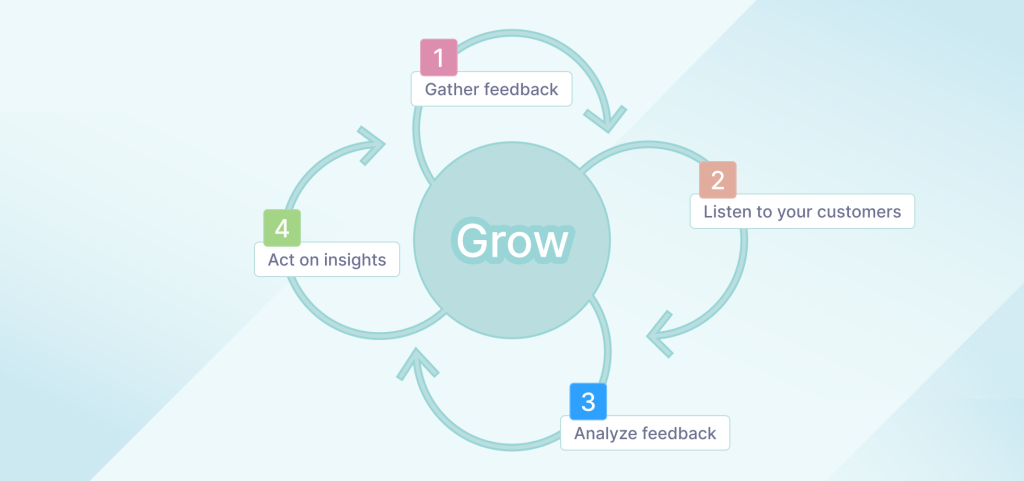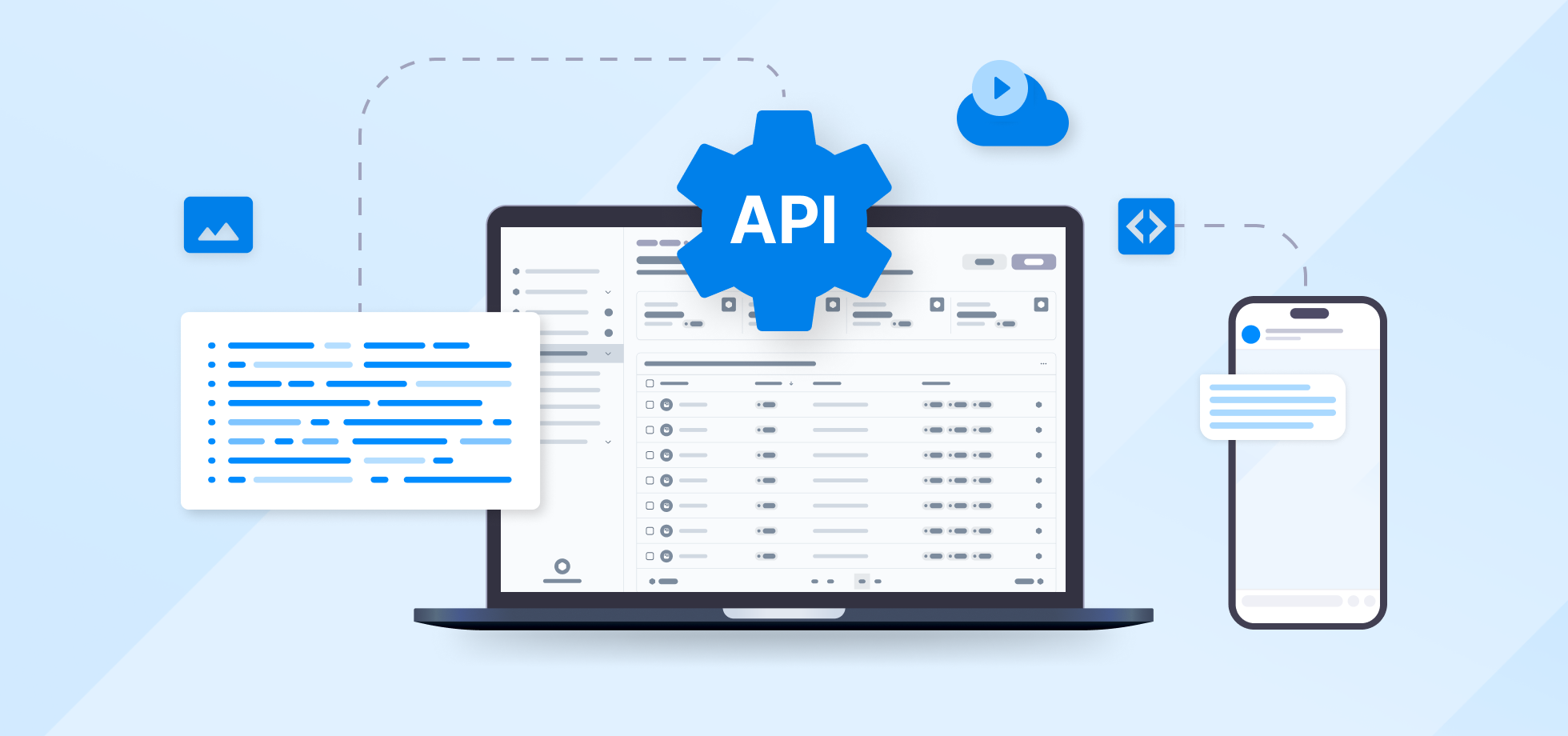
Feedback is what separates thriving businesses from those stuck in survival mode. Companies that actually listen to their customers and tie satisfaction to real business goals are 29% more likely to get bigger budgets for improving customer experience.
In other words, happy customers lead to better business. But here’s the catch: collecting feedback is pointless if you don’t act on it. That’s where a closed feedback loop comes in — turning customer insights into real changes that keep them coming back.
This article will explain the five easy steps and best practices you must follow to build that system and drive business growth.
What is a closed feedback loop?
A closed feedback loop is a system that uses client feedback to adjust products to become a better fit for the end customer.
It is used to maintain desired performance levels, optimize performance, and ensure stability. It functions based on output analysis and the constant tweaking of inputs to obtain the best possible results.
In a closed feedback loop, what comes out of the system is constantly monitored, and the feedback received is used to change what goes into it.
Why a closed feedback loop is important in marketing
Closing the feedback loop refers to the process of collecting feedback from customers, analyzing that feedback, and then taking action based on it to improve the customer experience. Implementing this process effectively can result in lower customer churn rates, optimized customer experiences, and other benefits for any business.
The benefits of a closed feedback loop
There are multiple benefits to closing the feedback loop, but the most important are:
Lower customer churn rates
Closing the feedback loop reinforces your brand’s commitment to customer satisfaction. Companies that actively seek out and respond to customer feedback are deemed more trustworthy and tend to gain more loyal customers, which, over time, significantly reduces churn rates.
Improved customer experience
Constantly tweaking your product based on recent customer feedback optimizes customer experiences and decreases customers’ likelihood of choosing the competition over you. It also helps develop new products and services based on a continuous analysis of collected customer feedback.
Improved brand reputation
When you set out to better meet customer needs, you show customers that their feedback is valued. This helps build trust between the client and your company, leading to increased loyalty, an improved brand reputation, and much lower chances of customers switching to the competition.
Increased revenue
When you focus on providing clients with the products/services they want, you can afford to charge more and are rarely faced with the issue of unsold inventories.
It’s also much cheaper to keep current customers happy than to find new ones. In other words, closing the feedback loop is much more profitable for you and your clients.

Another major advantage of the closed feedback loop that translates into higher profits is the innovative side of the package. The product development phase is where you’ll best be able to see how the closed feedback loop works and where major product changes occur.
Try focusing on anticipating your customers’ needs rather than simply fulfilling them. Most clients don’t know what they want until you offer it; this is where innovation comes in.
As your product evolves, beta testers report feedback on their experience, enabling you to make necessary adjustments. This results in a better product and, over time, increased revenue.
The best practices for a closed feedback loop

Let’s see how you can implement a closed feedback loop, which channels you should use, and how to evenly distribute your team’s effort:
Follow up with customers in a reasonable timeframe
Here’s how to achieve that with little or no hassle:
- Promptly respond to customer feedback
- Acknowledge your customers’ concerns
- Provide solutions or remedies
All of the above can be done by setting up an automated email or chatbot to respond to customer feedback instantly and ensuring that your customer service team follows up with the desired solution.
An example is provided by Pela Case, a sustainable phone case company that offers eco-friendly cases made from plant-based materials. They are known for their exceptional customer service and commitment to sustainability and have put in place a dedicated customer service team that responds to all customer inquiries within 24 hours. Their support network includes email, social media, and their website’s live chat feature.
Reach as many customers as possible
To reach many customers in a limited period, use multiple channels and platforms to gather customer feedback and get access to a broader audience.
You can use cost-effective tools like surveys, polls, and reviews to gather your desired information. Airbnb does a great job of using multiple platforms for feedback collection. These include their website, mobile app, email, and social media channels.
Pay attention to recurring issues
Repeating issues and patterns tell you everything you need to know to improve the shopping experience: they disclose potential missing links in the delivery process, customer service areas that could be improved, and product features you need to consider and potentially implement.
Collect data from every customer touchpoint, then see which issues clients signal most often. Textmagic offers a comprehensive, 360-degree view of the customer journey, providing detailed info about each time a customer comes into contact with your brand so that you don’t have to manually search for customer info. It’s all there, under one dashboard.
Prioritize complaints
Complaints sum up the most urgent and pressing issues that customers face. Responding quickly and effectively to every complaint can help prevent customers from becoming frustrated or angry.
Additionally, addressing complaints can help businesses identify areas for improvement and ultimately enhance the overall customer experience.
To prioritize complaints effectively, businesses should have a clear system for tracking and addressing customer feedback. This might include using a dedicated email address, feedback form, or social media channel for customers to submit complaints.
It’s also important to respond promptly to complaints, acknowledge the customer’s concerns and provide a timeline for resolution. Ideally, businesses should aim to resolve complaints within 24-48 hours or, at the very least, provide a status update to the customer within that time frame.
Involve people outside support
The key to creating a closed feedback loop is obtaining detailed customer feedback you can act on immediately. This is how customer-centric businesses are run. The system works so well because it is based on optimizing the customer experience across every channel.
Your customer support system is an important part of the customer journey, but the customer experience goes way beyond support nowadays. Every contact a client makes with your brand is a potential source of feedback, so you need to review every customer interaction and even create new ones.
This is where your entire team should get involved:
- PR specialist
- Social media wiz
- Even an HR representative
Every platform your team members use is a potential source of feedback.
Engaging with customers on social media is among the easiest and most effective ways to understand customer desires and address issues proactively. This engagement builds trust and fosters stronger relationships. In fact, 75% of consumers trust online reviews, and 90% read them before making a purchase.
So, when businesses actually show up, respond, and engage, they’re not just fixing issues — they’re building trust and keeping customers loyal.
Process and act on customer feedback
Collect feedback from multiple sources (live chat, surveys, social media, etc.), then ask the right questions to obtain the extra information you need.
Open questions like “What else could we have done to improve your experience?” show you care and offer more actionable insights about the shopping experience.
Provide incentives for every feedback you obtain to get more customers to share their experiences with your brand.
Include brief surveys in your emails so you can gather feedback more effectively. Here are the most popular surveys to consider:
- NPS (Net Promoter Score) — measures customer loyalty
- CSAT (Customer Satisfaction) — measures customer satisfaction
- CES (Customer Effort Score) — determines how much effort it takes to complete an interaction
- Product/Market fit (PMF) — compares product attributes to market demands
- Thumbs up/down — a two-option customer sentiment evaluation
- Smiley face — measures customer happiness based on a scale of facial expressions
- 5-star — measures customer sentiment based on an intuitive star scale
Implement a closed feedback loop in 5 easy steps
When you need to let clients know that you have received their feedback and are taking active steps to improve, do the following:
1. Acknowledge
Make clients feel heard and valued for submitting their feedback. Respond to their comments, and don’t leave out the negative ones.
2. Prioritize
Prioritize feedback based on importance and impact to ensure critical issues are addressed first. Negative feedback often comes first because it could signal a recurring issue requiring immediate action.
3. Respond
Jump in fast — even if you don’t have an immediate fix. Customers just want to know you’re listening. Acknowledge their concerns, take the time to figure out the real issue, and then deliver a solid solution. Keep in mind that 48% of consumers expect a response to social media questions and complaints within 24 hours.
4. Act
Implement useful solutions addressing feedback to improve the user experience. If your customers have issues with your product or service, try to develop new features. If they complain about extensive queue times in customer service, train your agents to deal with things faster.
5. Communicate
Get back to your clients and tell them you have taken active steps to address their feedback. You can do this via email, social media, or other channels. Acknowledge their contributions by posting their suggestions on your website or social media.
Start building a closed feedback loop today
Still wondering why feedback matters so much? Consider this: 72% of consumers are loyal to at least one company. This underscores the importance of promptly responding to customer feedback to enhance your brand’s reputation and foster lasting customer loyalty.
Businesses implementing closed feedback loop systems are more likely to succeed in today’s competitive market. By actively listening to their customers and continuously improving their products or services, they can create a loyal customer base and drive growth and expansion.
Frequently Asked Questions (FAQs)
A closed feedback loop is a system that captures customer insights, acts on them, and then reports back to the customer, turning opinions into real improvements. It’s vital because simply collecting feedback without action wastes effort. A well-executed feedback loop turns insights into loyalty, and loyalty into revenue.
Closing the loop helps:
- Reduce churn by showing customers their concerns matter.
- Improve customer experience through continuous product enhancements.
- Enhance brand reputation by demonstrating responsiveness.
- Boost revenue via customer loyalty, upsells, and innovation-driven offers.
Use a multi-channel approach to reach more customers efficiently. Tools include surveys, support tickets, live chat, social media, email, and polls. Gathering feedback across all channels leads to more accurate and representative insights.
- Focus first on recurring or urgent issues, as these impact the most users.
- Respond within 24–48 hours (or sooner), with at least an acknowledgment or update.
- Even when you don’t have a complete solution, prompt acknowledgment tells customers you’re listening.
Feedback shouldn’t be confined to support teams. It must involve marketing, PR, HR, product managers, and more. Every team and channel (from HR chats to Instagram DMs) can uncover insights that really shape smarter moves.
Here is a basic five-step process:
- Acknowledge feedback and thank customers.
- Prioritize based on impact and urgency.
- Respond quickly, even if only to say you’re investigating.
- Implement changes or fixes informed by feedback.
- Follow up with customers to inform them how their input shaped improvements.
Related articles
7 Text marketing trends and predictions for 2025
As we usher in 2025, we can’t help but notice how th...
10 Best SMS gateway APIs to send text messages
Effective communication enhances relationships, boos...
Mastering internal product documentation: Our proven 5-step approach
Explore our process of converting abstract ideas int...
Top 20 best marketing automation tools to use in 2025
Explore the best marketing automation tools, with de...
5 Easy Pipedrive SMS integrations with Textmagic and Zapier
Pipedrive is a CRM software for businesses of all si...




